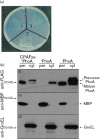Secretion of the chlamydial virulence factor CPAF requires the Sec-dependent pathway
- PMID: 20522495
- PMCID: PMC3068695
- DOI: 10.1099/mic.0.040527-0
Secretion of the chlamydial virulence factor CPAF requires the Sec-dependent pathway
Abstract
The chlamydial protease/proteasome-like activity factor (CPAF) is secreted into the host cytosol to degrade various host factors that benefit chlamydial intracellular survival. Although the full-length CPAF is predicted to contain a putative signal peptide at its N terminus, the secretion pathway of CPAF is still unknown. Here, we have provided experimental evidence that the N-terminal sequence covering the M1-G31 region was cleaved from CPAF during chlamydial infection. The CPAF N-terminal sequence, when expressed in a phoA gene fusion construct, was able to direct the export of the mature PhoA protein across the inner membrane of wild-type Escherichia coli. However, E. coli mutants deficient in SecB failed to support the CPAF signal-peptide-directed secretion of PhoA. Since native PhoA secretion was known to be independent of SecB, this SecB dependence must be rendered by the CPAF leader peptide. Furthermore, lack of SecY function also blocked the CPAF signal-peptide-directed secretion of PhoA. Most importantly, CPAF secretion into the host cell cytosol during chlamydial infection was selectively inhibited by an inhibitor specifically targeting type I signal peptidase but not by a type III secretion-system-specific inhibitor. Together, these observations have demonstrated that the chlamydial virulence factor CPAF relies on Sec-dependent transport for crossing the chlamydial inner membrane, which has provided essential information for further delineating the pathways of CPAF action and understanding chlamydial pathogenic mechanisms.
Figures





References
-
- Betts, H. J., Wolf, K. & Fields, K. A. (2009). Effector protein modulation of host cells: examples in the Chlamydia spp. arsenal. Curr Opin Microbiol 12, 81–87. - PubMed
-
- Bhatnagar, R. & Batra, S. (2001). Anthrax toxin. Crit Rev Microbiol 27, 167–200. - PubMed
-
- Campbell, L. A. & Kuo, C. C. (2004). Chlamydia pneumoniae – an infectious risk factor for atherosclerosis? Nat Rev Microbiol 2, 23–32. - PubMed
Publication types
MeSH terms
Substances
LinkOut - more resources
Full Text Sources
Other Literature Sources

